Experimental and Numerical Study on the Failure Characteristics of Brittle Solids with a Circular Hole and Internal Cracks
Abstract
:1. Introduction
2. Research Scheme and Sample Preparation
2.1. 3D-ILC
2.2. Sample Material
2.3. Experimental Conditions
- (1)
- Group A (complete orifice sample without internal cracks). The control group with no internal cracks, the samples were loaded to crushing to provide comparison for the orifice samples (Group B and Group C) with internal cracks of different buried depths, which is marked as A0.
- (2)
- Group B (orifice samples with internal cracks of different buried depths). Samples buried at depths (d) 0.5, 1, 1.5, and 2 cm, which are marked B0.5–B2.5. The samples were loaded to crushing to observe the propagation of internal crack, the characteristic loads and other information during the loading process, and the fracture morphology was observed after the specimen was crushed.
- (3)
- Group C. The samples were the same as group A and B, but the loading stopped when the main crack and the remote crack appeared, which were recorded accordingly. The samples were marked Ci-j, where i ranges from 0 to 2, representing samples without internal cracks and samples with cracks in different buried depths. The values of j range from 1 to 2, representing the occurrence of main cracks and remote cracks.
2.4. Sample Preparations
- (1)
- Group A (samples without internal cracks): The sample was a cubic sample of 80 × 80 × 40 mm3 with a circular hole in the center, with a diameter that was 20 mm as shown in Figure 1a.
- (2)
- Group B and C (samples with internal cracks): The sample was a cubic sample of 80 ×80 × 40 mm3, with a circular hole in the center and a circular inner crack, with a diameter that was 2c = 13 mm. The d between the inner crack and the top surface of the sample was 0.5, 1, 1.5, and 2 cm, respectively, as shown in Figure 1b.
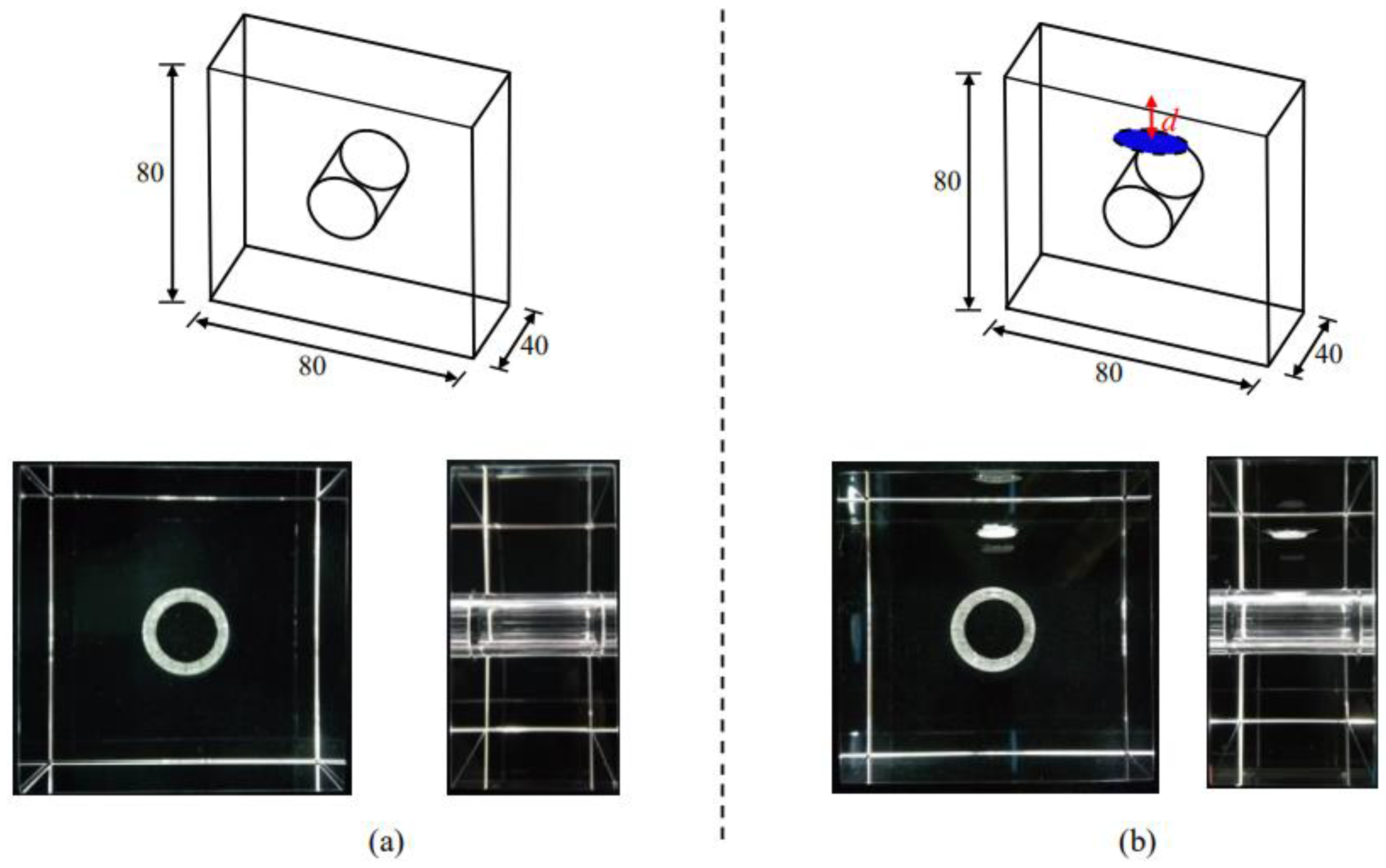
2.5. Test Instruments
2.6. Birefringence Effect Observation System
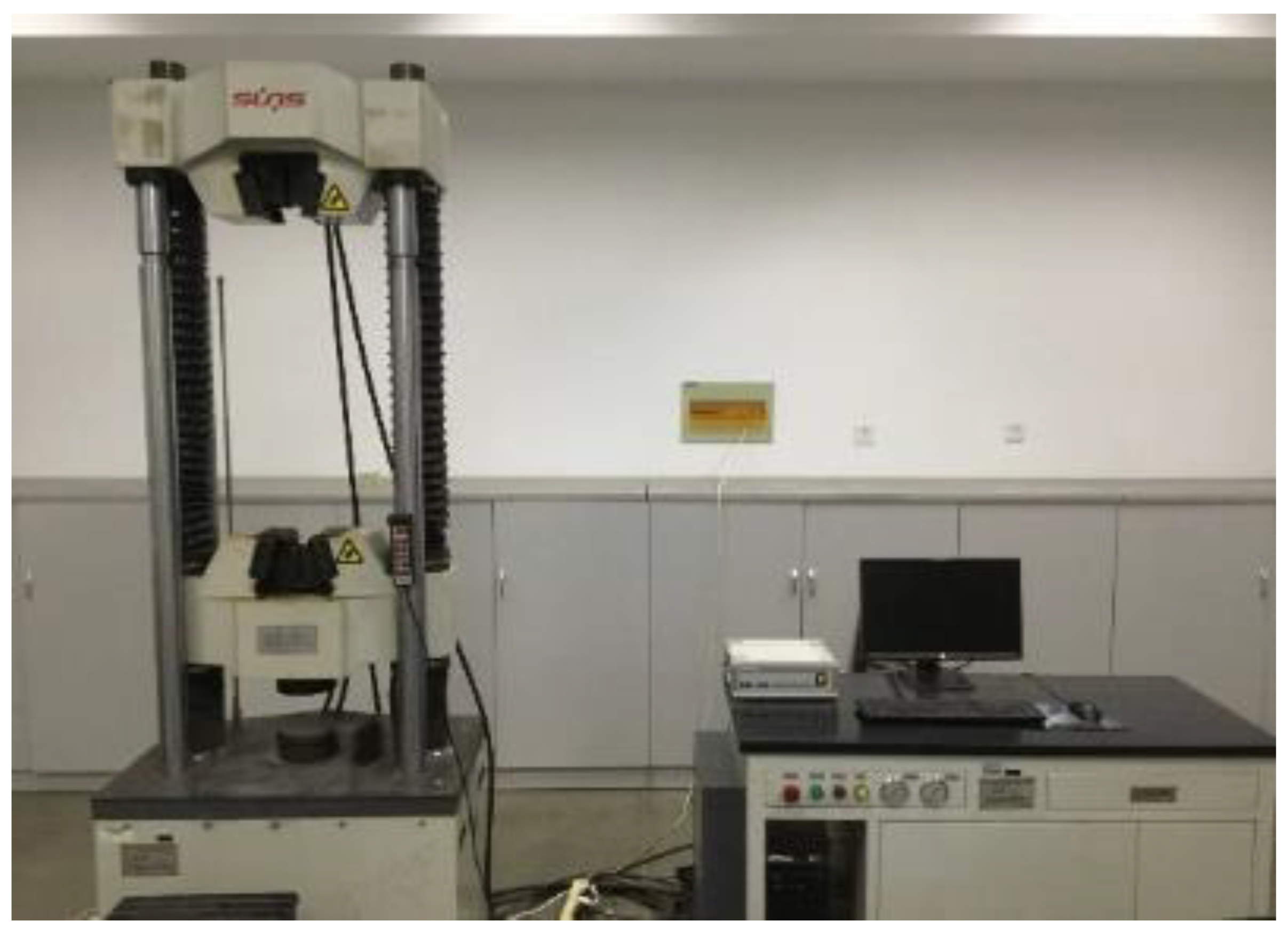
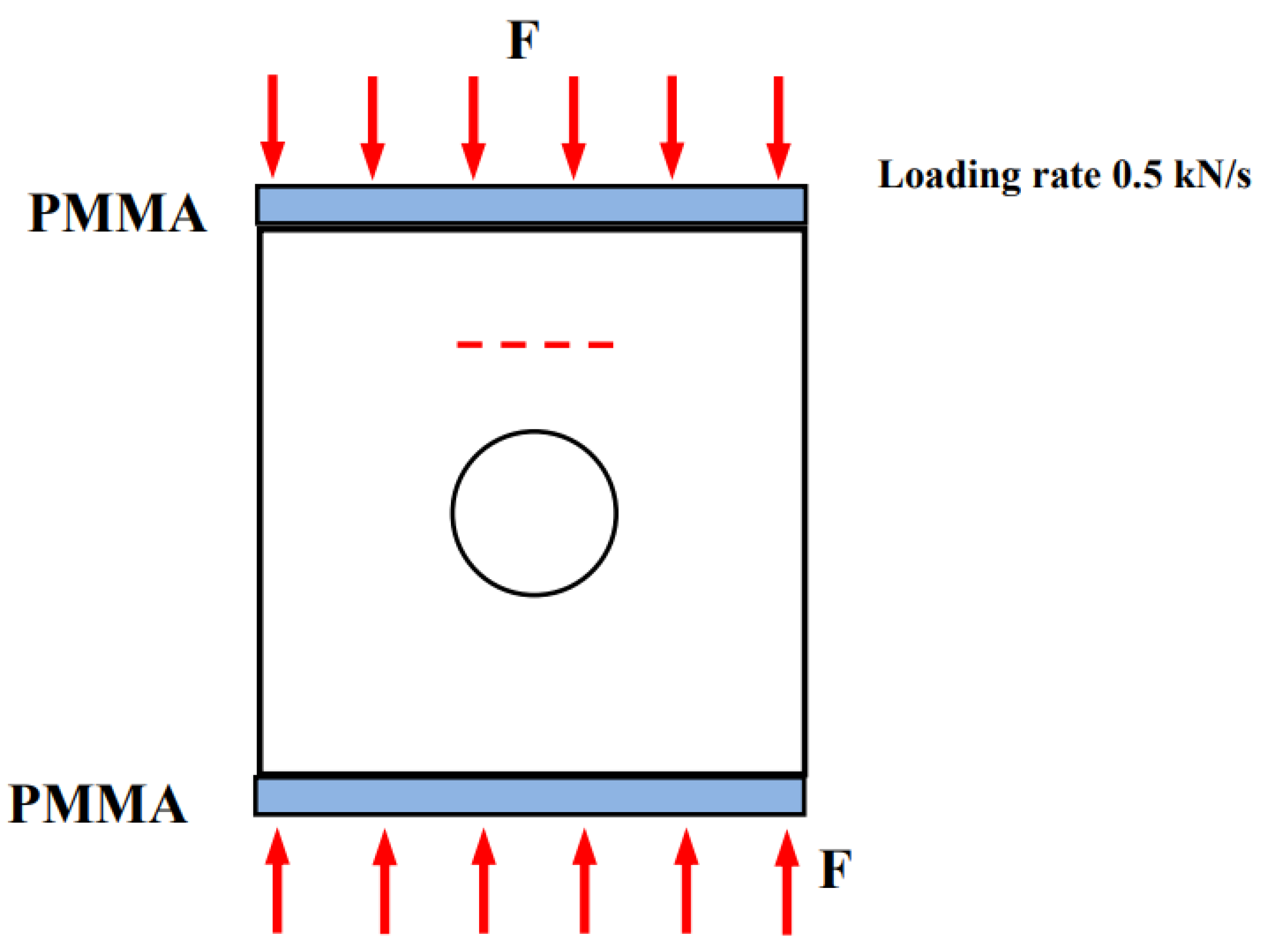
3. Experimental Results
3.1. Failure Process Analysis
3.1.1. Orifice Sample without Internal Cracks (Group A)
- (1)
- Stable stage: This stage persists until the loading force to 131.16 kN. No crack propagation was observed in this stage;
- (2)
- Main crack propagation stage: when loading to 131.16 kN, the upper and lower main cracks initiated almost simultaneously, and the main crack’s growth rate gradually decreased after the crack initiation.
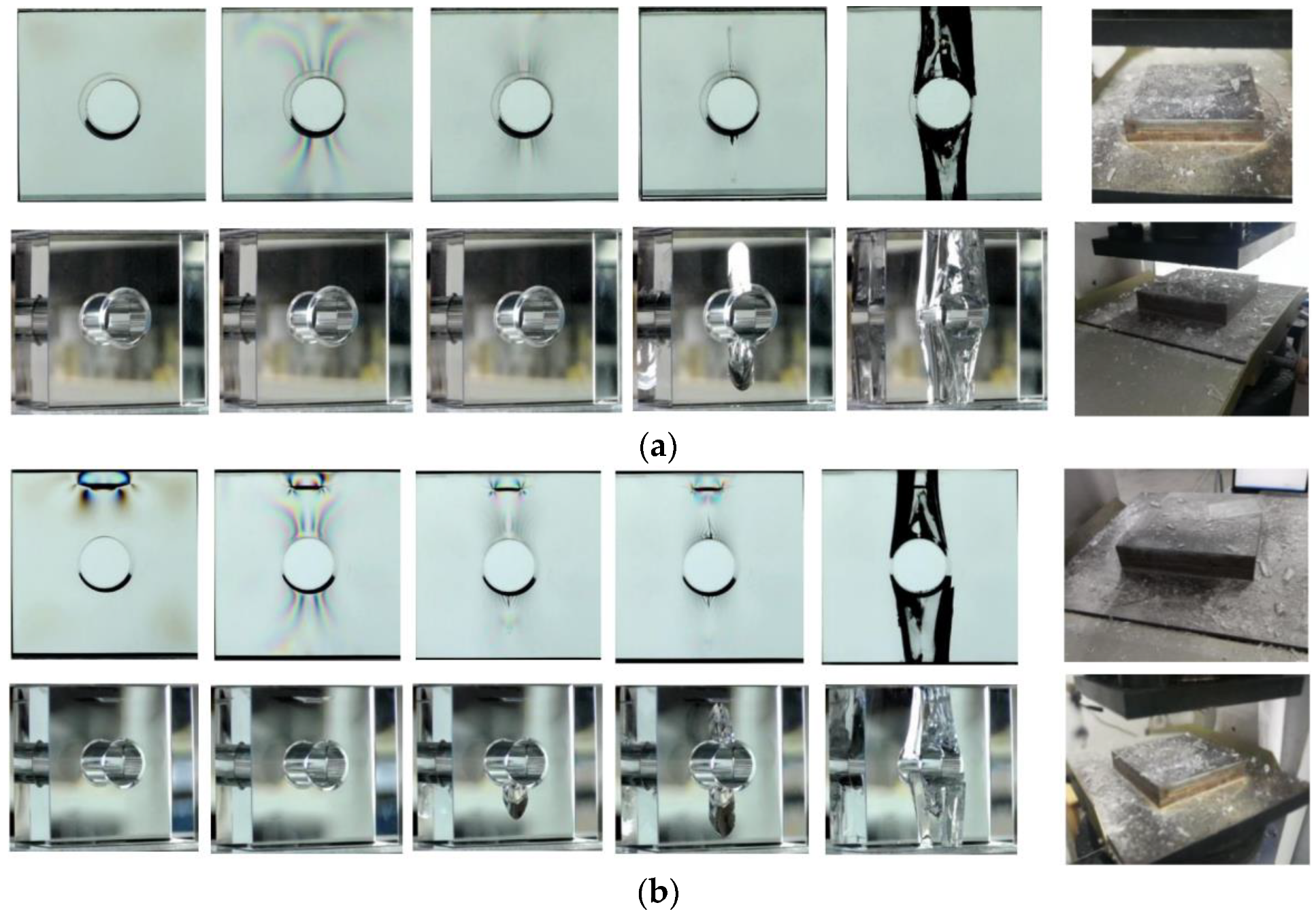

- (3)
- Remote crack propagation stage: The orifice sample with no internal cracks did not continue to exhibit “bisection” fracture failure along the main crack, but it produced two pairs of remote cracks at the symmetrical positions above and below the orifice when the load was 438.25 kN. The surface was curved and tangent to the orifice. The line between the tangent point and the center of the circular hole was at an angle of approximately 30° with the horizontal axis. The occurrence time of the upper and lower remote cracks is similar;
- (4)
- Failure stage: When the failure load reached 587.13 kN, the sample showed violent “explosive” failure, and the sample was detrital with a long range of avalanche. This characteristic is typical of brittle material failure under ballast loads of a rigid testing machine.
3.1.2. Orifice Sample with Internal Cracks (Group B)
- (1)
- Stable stage: This stage persisted until a loading force of 77.12 kN. No crack propagation was observed during this stage.
- (2)
- Main crack propagation stage: When loading to 77.12 kN, the upper main crack first initiated, and when the load reached 89.61 kN, the lower main crack initiated. The main crack initiation load of samples containing internal cracks was less than that of samples not containing internal cracks. Meanwhile, the internal cracks also influenced the stress field of the sample, which led to the upper main crack becoming easier to initiate than the lower main crack. What should be noticed is that for the samples with lower buried depths (d = 0.5, 1, and 1.5 cm), the main crack would not “penetrate” the prefabricated internal crack. However, when the buried depth is higher (d = 2 cm), the main crack would “penetrate” the prefabricated internal crack;
- (3)
- Remote crack propagation stage: When loaded to 368.72 kN, remote cracks appeared, and the crack form was similar to that of the sample without internal cracks, but the initiation load of remote cracks was smaller than that of the sample without internal cracks;
- (4)
- Failure stage: When the load reached 397.61 kN, there was a violent “explosive” failure, and the failure load was significantly lower than that of the complete orifice sample without crack.
3.2. Stress Moire Laws
- (1)
- When the pressure was relatively lower, the stress moire presented the shape of a “flame” in the top and bottom of the orifice for the condition of the sample without internal cracks. However, for the condition of the sample with internal cracks, the “petal shape” stress moire was observed in the tips of internal crack;
- (2)
- With the increase in load, the petal moire at the tip of the prefabricated crack gradually became lighter, while the flame moire at the upper and lower part of the orifice gradually highlighted;
- (3)
- The appearance of the main crack in the upper and lower part of the orifice changed the moire distribution of the “flame shape” and made the moire appear similar to an “inverted triangle” along the direction of the main crack propagation.
3.3. Crack Initiation and Failure Load

- (1)
- For samples with internal cracks, the proportion of crack initiation load to final failure load was 19.4% for the upper main crack, 22.5% for the lower main crack, and 92.7% for the remote crack. For the sample without internal cracks, the upper main crack was 22.3%, the lower main crack was 22.3%, and the remote crack was 74.6%;
- (2)
- The existence of prefabricated cracks greatly reduced the values of each characteristic loads. Compared with the orifice sample without internal cracks, the average load of the upper main crack, lower main crack, remote crack, and final failure of the specimen with internal cracks were reduced by 41.2%, 31.7%, 15.9%, and 32.3%, respectively.
4. Fractography Characteristics
4.1. Main Crack Surface Characteristics
4.1.1. Circular Arc Characteristics of Crack Tip
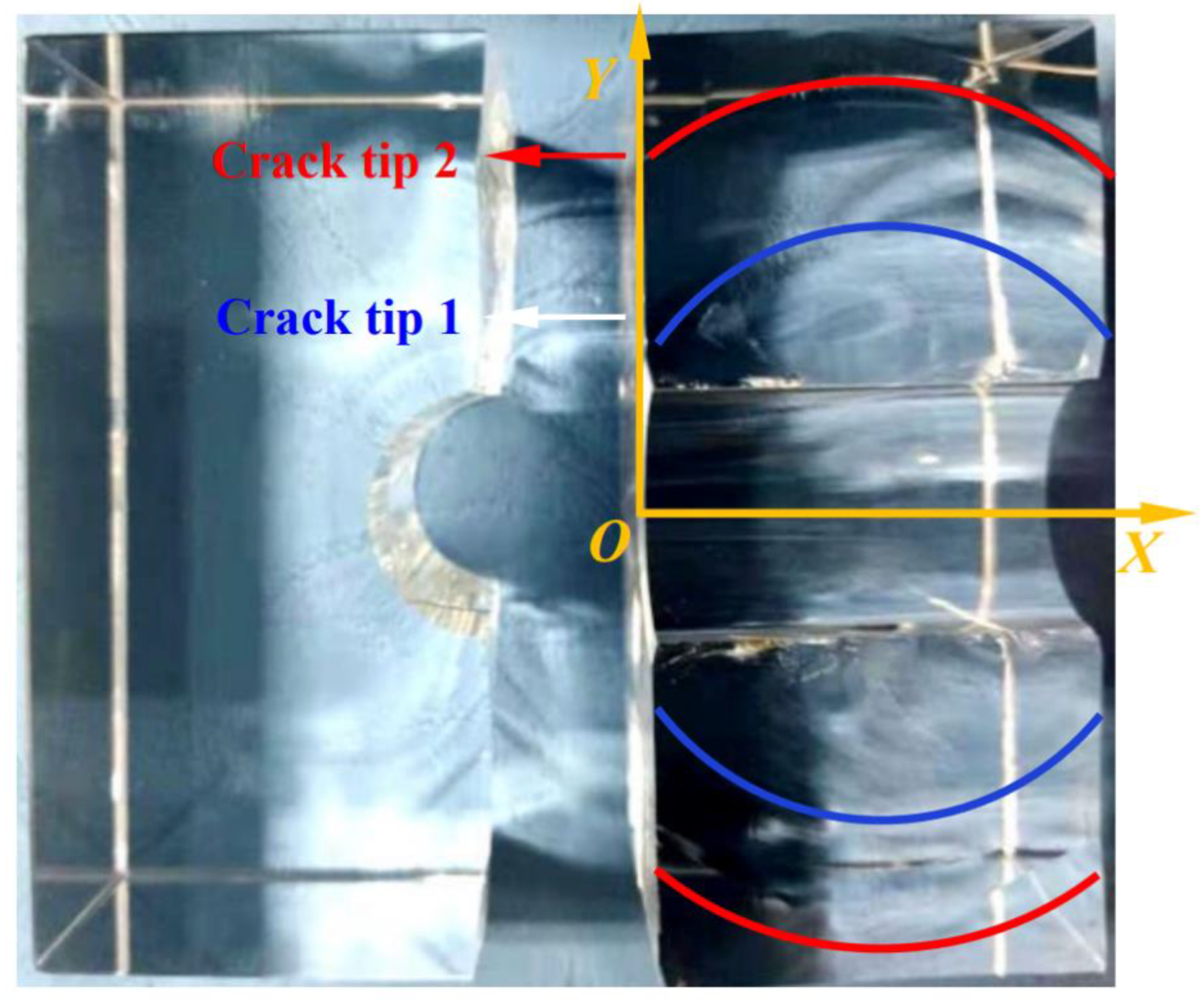
4.1.2. Dynamic Fracture Characteristics

4.1.3. Secondary Wallner Lines
4.2. Remote Crack Surface Characteristics
4.2.1. Dynamic Fracture Characteristics
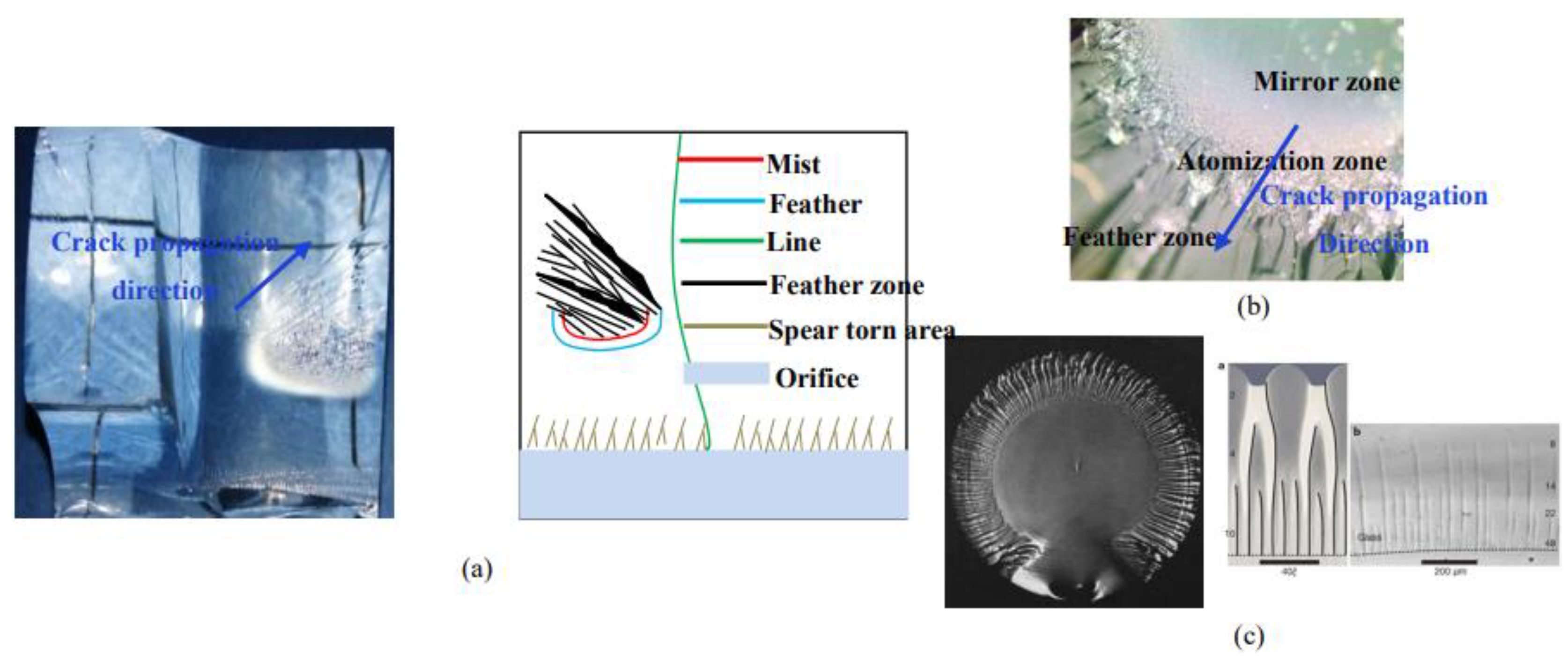
4.2.2. Characteristics of Tearing III—Shaped Crack
4.3. Crack “Penetration”
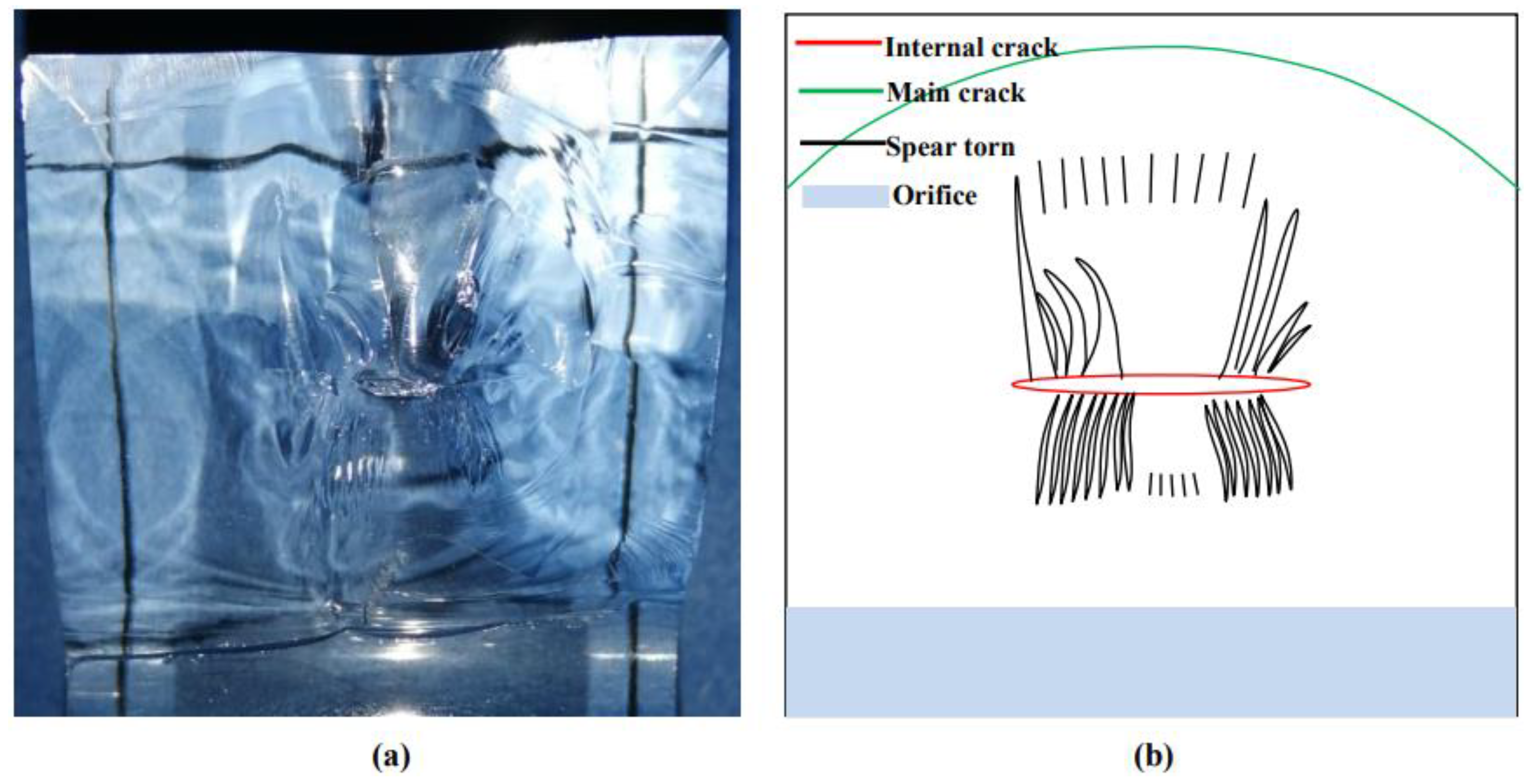
5. Numerical Simulations
5.1. Stress Intensity Factor Calculation
5.2. Crack Propagation Criterion
5.3. Numerical Models
5.4. Numerical Results
5.4.1. Effects of Different Buried Depths on the Initiation of Main Crack
5.4.2. Main Crack Propagation Process
- (1)
- After initiation, the main crack presents self-similar propagation along the crack surface, which is consistent with the experimental phenomenon. According to the stress intensity factor distributions, the Mode 2 and Mode 3 stress intensity factors of the main crack growth process are 0, which can determine that the main crack is pure mode I fracture;
- (2)
- In the process of main crack propagation, the crack tip presented a circular arc feature. According to the distribution of stress intensity factor, it can be seen that the part near the main crack to the sample surface had a larger KI, while the stress intensity factor in the middle of the main crack is smaller. Therefore, the part near the sample surface had a faster crack growth, while the middle part had a slower crack growth. Therefore, the radius of the arc gradually increased with the growth of the main crack, which is consistent with the fracture characteristics of the main crack in Section 4.1.1 of this paper;
- (3)
- It can be seen from the pattern of Mode I stress intensity factor over time that the mode I stress intensity factor decreases gradually during the growth of the main crack, which is consistent with the experimental phenomenon that the growth rate of the main crack decreases gradually after initiation in this paper.
5.4.3. Effects of Main Crack Generation and Propagation on Remote Crack
6. Conclusions
- (1)
- No matter whether the orifice sample contains internal crack or not, the crack morphology is main crack and remote crack. At the initiation of the main crack, there is a dynamic fracture feature near the orifice, and the tip is arc-shaped. The radius of the arc gradually increases in the process of propagation, while the growth rate becomes slower and slower. When the prefabricated crack buried depth is relatively larger, it “penetrates” the prefabricated crack, and presents a "tentacle-like" shape at the surface of the main crack. The surface of the remote crack is curved and tangential to the orifice. The tangential part presents mode III spear feature, and dynamic fracture occurs on the crack surface;
- (2)
- Stress birefringence can be used to qualitatively monitor the dynamic change of stress in the sample with 3D-ILC internal crack. The existence of internal crack changes the original “flame” moire distribution of the orifice sample, and the moire at the prefabricated crack tip presents "petal" characteristics;
- (3)
- The presence of prefabricated cracks reduced the characteristic load of the sample, the upper main crack decreased 41.2%, the lower main crack decreased 31.7%, the remote crack decreased 15.9%, and the failure load decreased 32.3%;
- (4)
- The results of qualitative stress analysis of the orifice sample were consistent with the crack initiation laws of the main crack and remote crack, and the numerical simulation of the crack propagation process based on the K distributions of M integral and MTS was consistent with the main crack propagation laws;
- (5)
- 3D-ILC can be applied to the study of crack propagation in brittle solids. Compared with the current mainstream method of transparent rock research, the embedded casting method has certain progress in approaching rock brittleness, crack authenticity, stress field visualization, fracture characteristics and other aspects.
Author Contributions
Funding
Institutional Review Board Statement
Informed Consent Statement
Data Availability Statement
Conflicts of Interest
References
- Ghalib, M.A.; Makky, S.M. Fatigue fracture of rotating circular disks. Eng. Fract. Mech. 1977, 9, 397–401. [Google Scholar] [CrossRef]
- Arutyunyan, A.R. A Fatigue-Fracture Criterion for Composite Materials. Dokl. Phys. 2019, 64, 394–396. [Google Scholar] [CrossRef]
- Molina, C.; Araujo, A.; Bell, K.; Mendez, P.F.; Chapetti, M. Fatigue life of laser additive manufacturing repaired steel component. Eng. Fract. Mech. 2020, 241, 107417. [Google Scholar] [CrossRef]
- Bolt, R.H.; Labate, S. Some Observations on the Acoustic Impedance of Small Orifices. J. Acoust. Soc. Am. 1948, 20, 596. [Google Scholar] [CrossRef] [Green Version]
- Tei, C.; Chin, K.; Vijayaraghavan, G.; Boltwood, C.M.; Shah, P.M. Paradoxical deterioration of left ventricular asynergy after administration of nitroglycerin. Am. J. Cardiol. 1985, 55, 677–679. [Google Scholar] [CrossRef]
- Romaniv, O.N.; Simin’Kovich, V.N.; Stepanov, V.G. Effectiveness of using a surface plastic strain to prevent crack development during cyclic loading. Mater. Sci. 1979, 15, 104–109. [Google Scholar] [CrossRef]
- Kanaun, S. On the hydraulic fracture of poroelastic media. Int. J. Eng. Sci. 2020, 155, 103366. [Google Scholar] [CrossRef]
- Zhao, K.; Stead, D.; Kang, H.; Gao, F.; Donati, D. Three-dimensional simulation of hydraulic fracture propagation height in layered formations. Environ. Earth Sci. 2021, 80, 435. [Google Scholar] [CrossRef]
- Kaurin, D.; Arroyo, M. Surface Tension Controls the Hydraulic Fracture of Adhesive Interfaces Bridged by Molecular Bonds. Phys. Rev. Lett. 2019, 123, 228102. [Google Scholar] [CrossRef] [Green Version]
- Zeng, K.H.; Xu, J.X. Unified semi-analytical solution for elastic-plastic stress of deep circular hydraulic tunnel with support yielding. J. Cent. South Univ. 2013, 20, 1742–1749. [Google Scholar] [CrossRef]
- Zhou, L.; Kai, S.U.; Zhou, Y.; Wen, X. Hydro-mechanical coupling analysis of pervious lining in high pressure hydraulic tunnel. J. Hydraul. Eng. 2018, 49, 313–322. [Google Scholar]
- Yang, T.; Zhu, W.; Yu, Q.; Liu, H. The role of pore pressure during hydraulic fracturing and implications for groundwater outbursts in mining and tunnelling. Hydrogeol. J. 2011, 19, 995–1008. [Google Scholar] [CrossRef]
- Lamé, G.; Lequien, M.; Pionnier, P.A. Interpretation and limits of sustainability tests in public finance. Appl. Econ. 2014, 46, 616–628. [Google Scholar] [CrossRef]
- Muskhelishvili, L.; Latendresse, J.R.; Kodell, R.L.; Henderson, E.B. Evaluation of Cell Proliferation in Rat Tissues with BrdU, PCNA, Ki-67(MIB-5) Immunohistochemistry and In Situ Hybridization for Histone mRNA. J. Histochem. Cytochem. 2003, 51, 1681–1688. [Google Scholar] [CrossRef] [Green Version]
- Lv, A.; Wang, Q. A new method for solving mapping function of roadway with arbitrary section shape by using optimization technique. J. Rock Mech. Eng. 1995, 03, 269–274. [Google Scholar]
- Fan, G.; Tang, C. The outfield mapping function of non-circular cavity is solved by the multiplication of three absolutely convergent series. J. Rock Mech. Eng. 1993, 03, 255–264. [Google Scholar]
- Mendelson, S.D.; Gorzalka, B.B. A facilitatory role for serotonin in the sexual behavior of the female rat. Pharmacol. Biochem. Behav. 1985, 22, 1025–1033. [Google Scholar] [CrossRef]
- Zhang, C.; Tang, J.; Teng, J. Experimental study on the effect of number and aperture of holes on mechanical properties of marble. Rock Soil Mech. 2017, 38, 41–50. [Google Scholar]
- Gong, F.; Wu, W.; Li, T. Experimental simulation of slab crack failure in deep rectangular hard rock tunnel. Rock Soil Mech. 2019, 40, 2085–2098. [Google Scholar]
- Zhu, T.; Jing, H.; Su, H. Experimental study on mechanical properties of sandstone with double circular holes under uniaxial compression. J. Geotech. Eng. 2015, 37, 1047–1056. [Google Scholar]
- Li, D.; Li, X.; Li, C. Experimental study on uniaxial compression mechanical properties of sandstone with double circular orifices. J. Rock Mech. Eng. 2015, 37, 1047–1056. [Google Scholar]
- Li, C.; Li, X.; Li, D. Particle flow analysis of failure characteristics of marble with orifice. J. Eng. Sci. 2017, 39, 1791–1801. [Google Scholar]
- Xie, L.; Zhu, W.; Wang, S. Parallel calculation and analysis of 3d fracture process of rock sample with orifice. J. Geotech. Eng. 2011, 33, 1447–1455. [Google Scholar]
- Wu, T.; Zhou, Y.; Wang, L. Mesoscopic study of pore-gap interaction mechanism under uniaxial compression. Rock Soil Mech. 2018, 39, 463–472. [Google Scholar]
- Zhu, T.; Jing, H.; Su, H. Experimental study on mechanical properties of porous and fissure combined defective sandstone. J. Coal 2015, 40, 1518–1525. [Google Scholar]
- Zhang, K.; Liu, T.; Yang, H. Physical test and numerical simulation of mechanical properties of rock mass with fissure after grouting. Hydrogeol. Eng. Geol. 2019, 46, 79–85+110. [Google Scholar]
- Fu, J.; Zhu, W. Study on fracture process of new material fracture body with 3d built-in fracture surface. J. Cent. South Univ. (Nat. Sci.) 2014, 45, 3257–3263. [Google Scholar]
- Li, S.; Yang, L.; Li, M. Effect of inclination Angle of 3d built-in fracture on tensile mechanical properties and fracture characteristics of rock-like materials. J. Rock Mech. Eng. 2009, 28, 281–290. [Google Scholar]
- Liu, J.; Yang, C.; Mao, H. Study on crack propagation and evolution of shale based on CT image processing. J. Zhejiang Univ. Technol. 2015, 43, 66–72. [Google Scholar]
- Guo, Y.; Zhu, W. Experimental study on three-dimensional propagation of embedded elliptic crack under compression and shear conditions. J. Solid Mech. 2011, 32, 64–73. [Google Scholar]
- Adams, M.; Sines, G. Crack extension from flaws in a brittle material subjected to compression. Tectonophysics 1978, 49, 97–118. [Google Scholar] [CrossRef]
- Dyskin, A.V.; Jewell, R.J.; Joer, H. Experiments on 3-D crack growth in uniaxial compression. Int. J. Fract. 1994, 65, R77–R83. [Google Scholar] [CrossRef]
- Ju, Y.; Xie, H.; Zheng, Z.; Lu, J.; Mao, L.; Gao, F.; Peng, R. Visualization of the complex structure and stress field inside rock by means of 3D printing technology. Chin. Sci. Bull. 2014, 59, 5354–5365. [Google Scholar] [CrossRef]
- Liu, H. Crack Propagation Law and Application of 3D Printing Technology in Prefabricated Cracked Rock-like Materials; China University of Mining and Technology: Beijing, China, 2018. [Google Scholar]
- Wang, H.; Zhang, J.; Ren, R. Implementation of 3D deep buried crack 3D-ILC based on electromagnetic field-medium damage. J. Geotech. Eng. 2018, 15, 1–13. [Google Scholar]
- Li, S.; Zhong, F. A review of 3d fracture research. Int. Seism. Dyn. 1993, 34, 1–4. [Google Scholar]
- Roesler, W.J.; Vandenbark, G.R.; Hanson, R.W. Cyclic AMP and the induction of eukaryotic gene transcription. J. Biol. Chem. 1988, 263, 9063–9066. [Google Scholar] [CrossRef]
- Knauss, K.G.; Wolery, T.J. Muscovite dissolution kinetics as a function of pH and time at 70 °C. Geochim. Cosmochim. Acta 1989, 53, 1493–1501. [Google Scholar] [CrossRef]
- Sommer, R.; Tautz, D. Minimal homology requirements for PCR primers. Nucl. Acids Res. 1989, 17, 6749. [Google Scholar] [CrossRef] [Green Version]
- Zheng, J.Y.; Deng, G.D.; Chen, Y.J. Experimental investigation on dynamic response and fracture characteristics of discrete multilayered thick-walled explosion containment vessels. Explos. Shock Waves 2005, 25, 506–511. [Google Scholar]
- Wang, H.; Le, C.; Tang, L. Based on 3D-ILC three point bending fracture characteristics of brittle solid with horizontal internal crack. Rock Soil Mech. 2021, 42, 2773–2784. [Google Scholar]
- Friedel, R.; Norman, D.A. The Psychology of Everyday Things. Technol. Cult. 1990, 31, 554. [Google Scholar] [CrossRef]
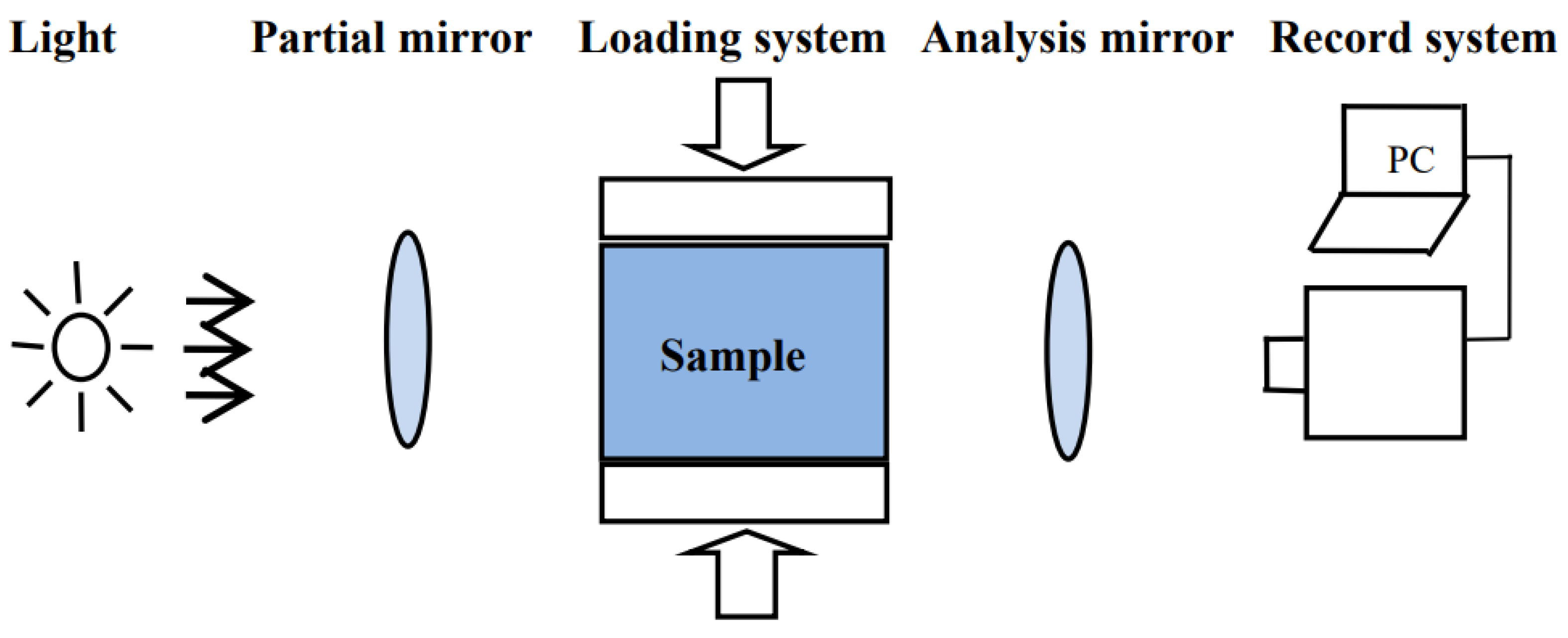
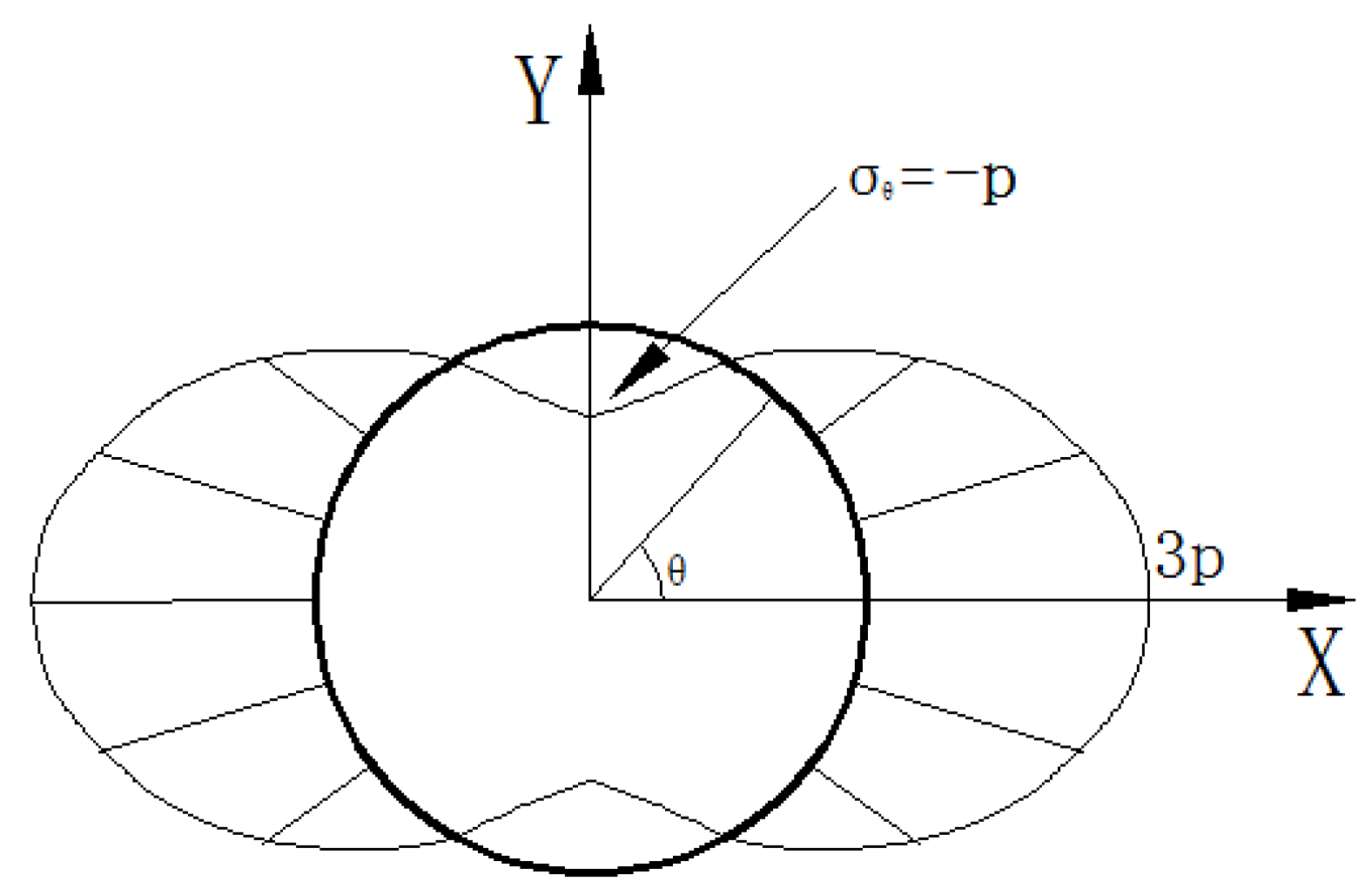
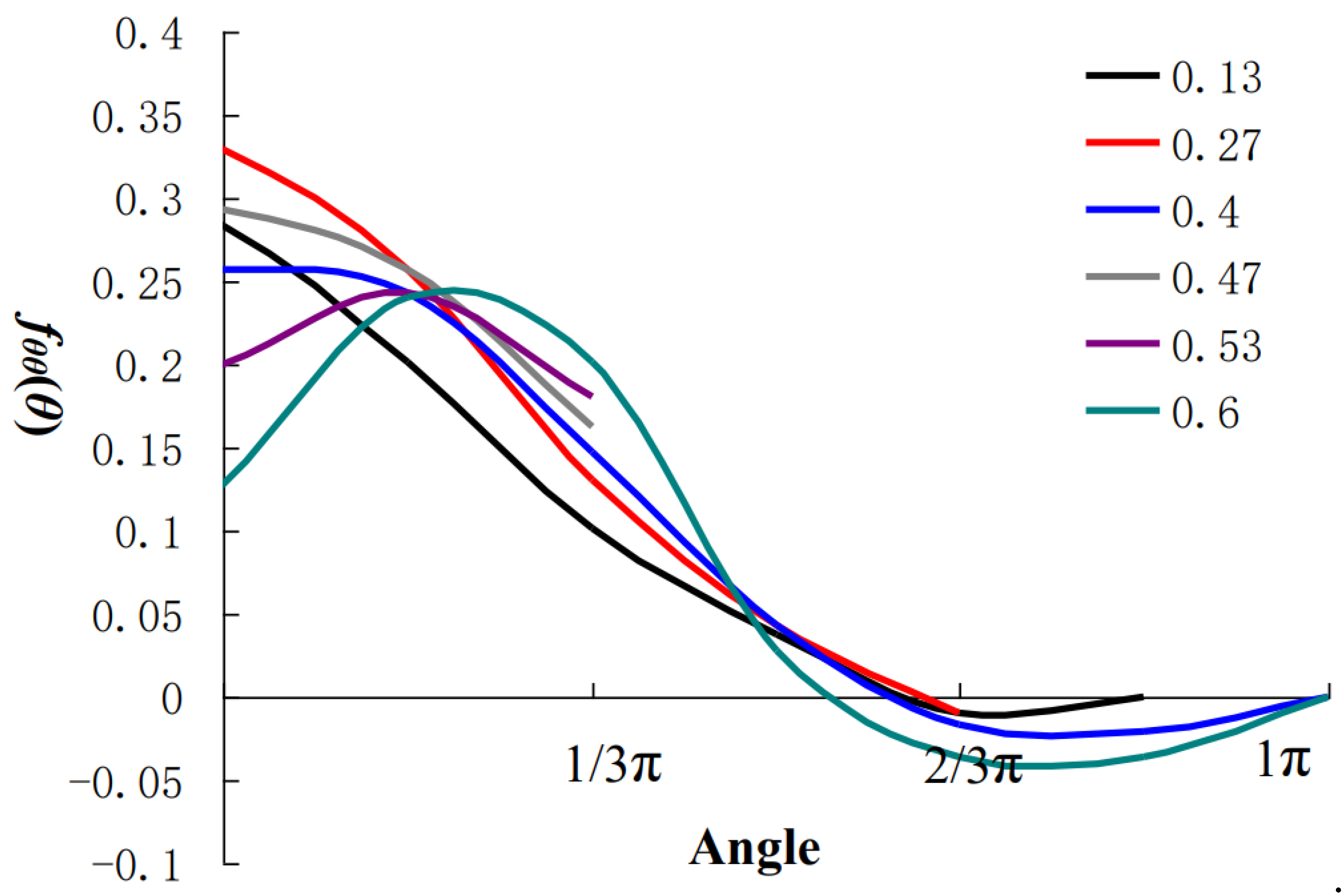
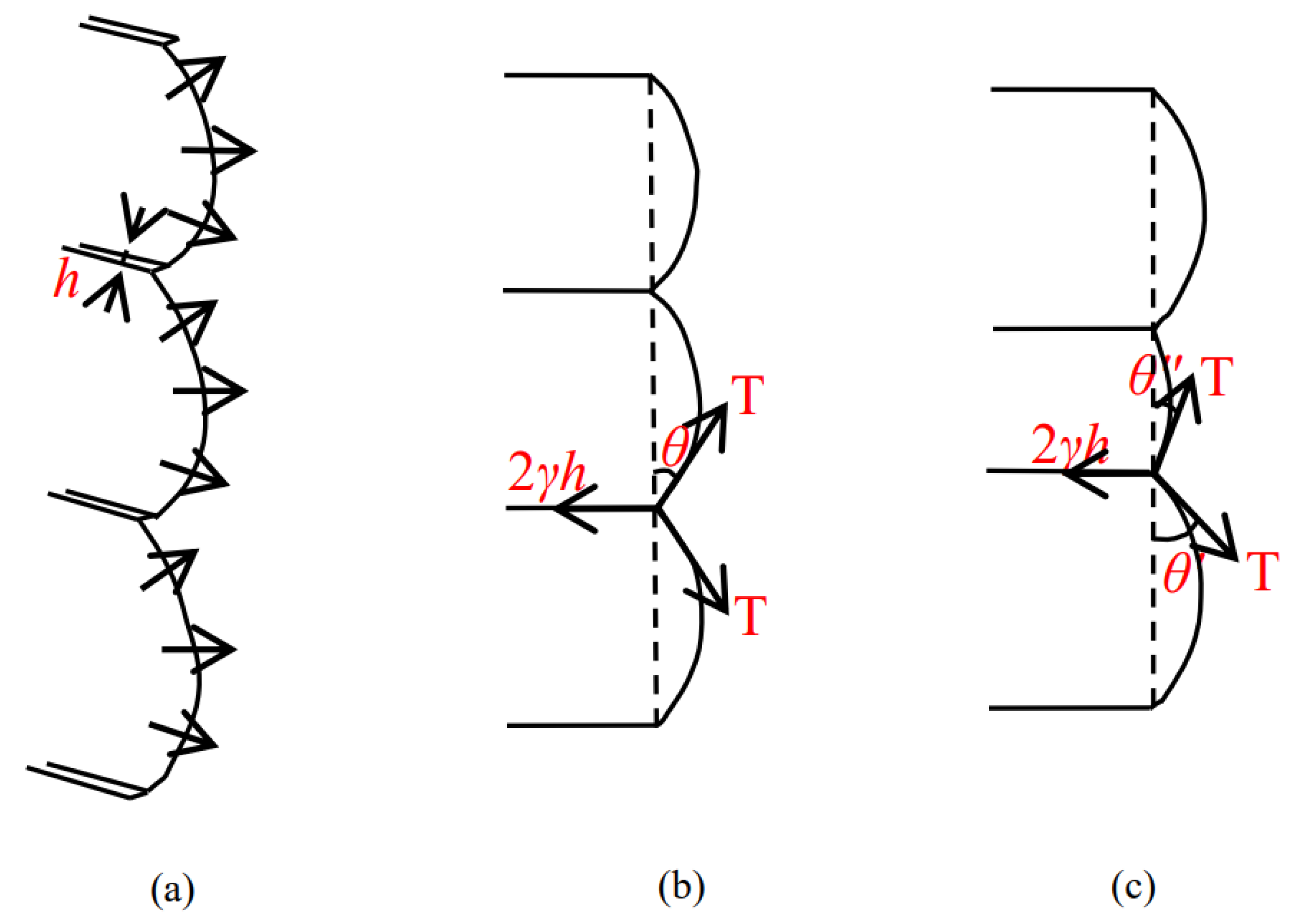
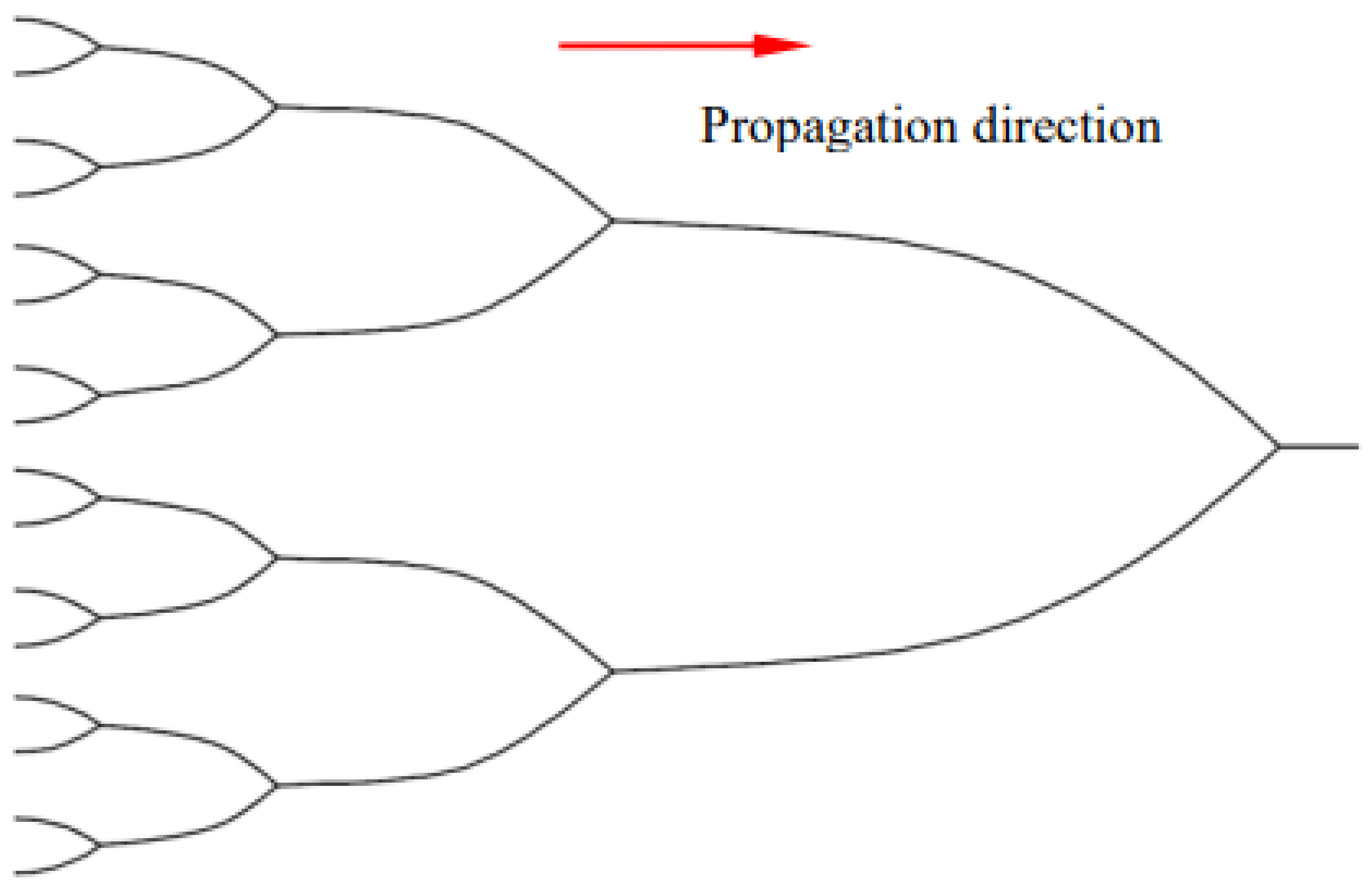


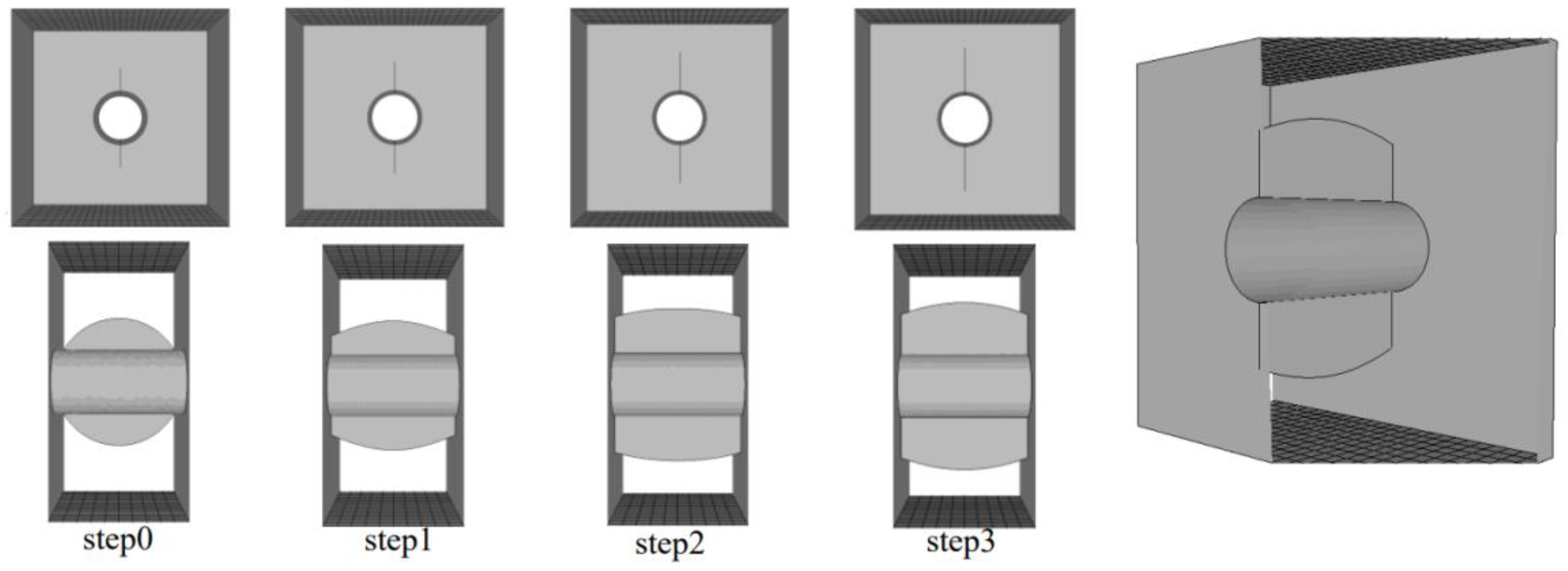
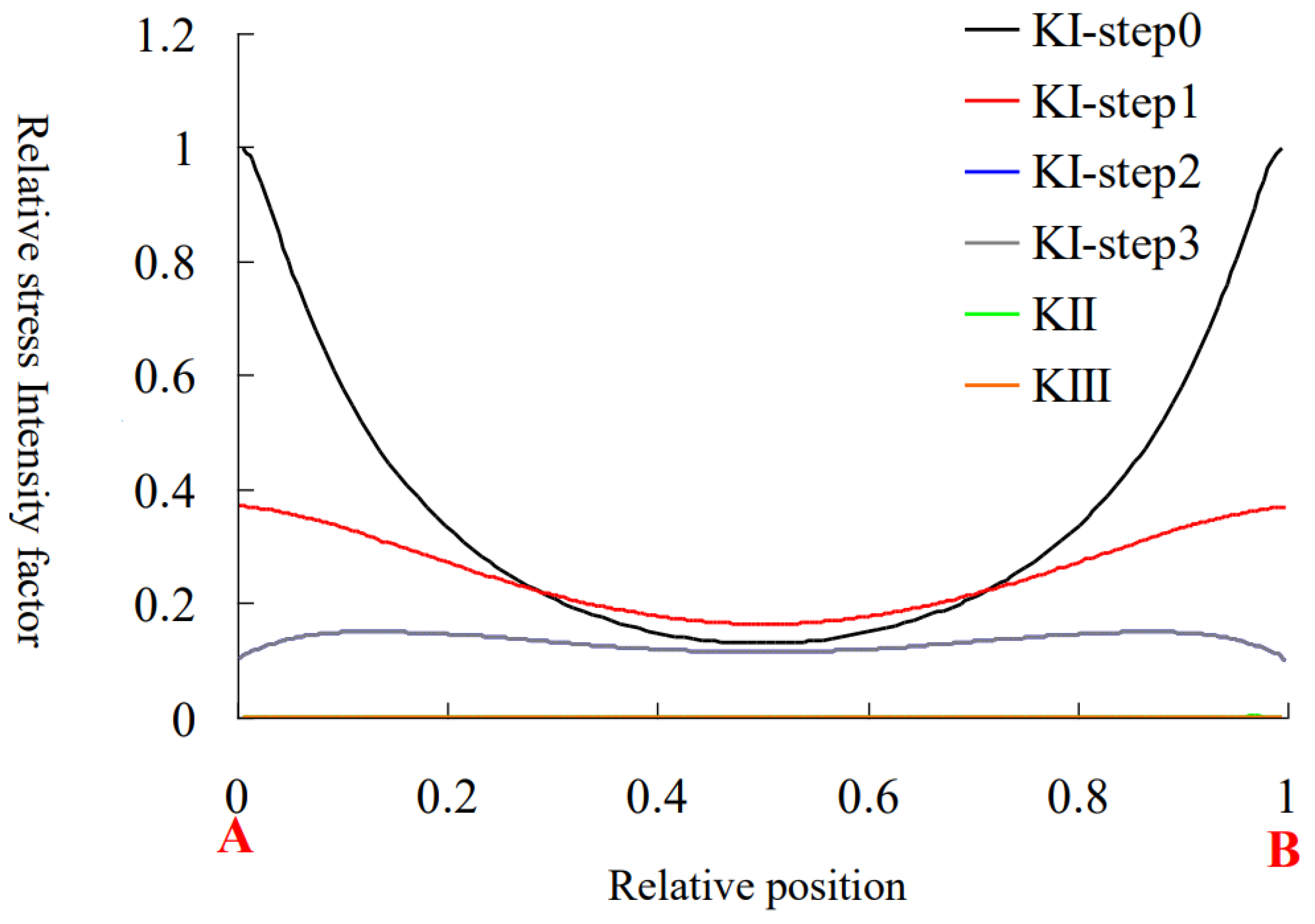
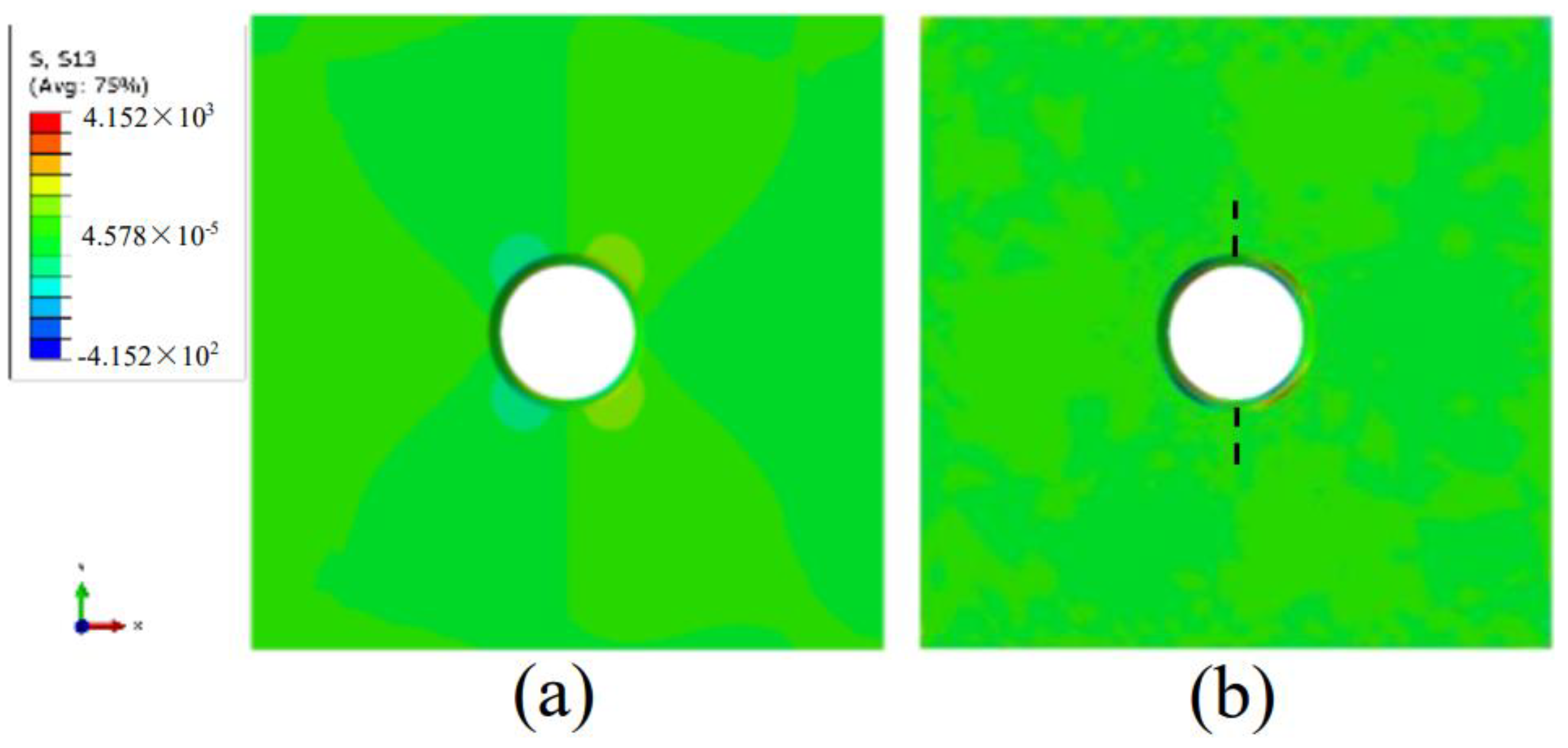
| Samples | Schematic Diagram | Number | Buried Depths/cm | Whether to Crush | Purpose |
|---|---|---|---|---|---|
| Samples without internal cracks |  | A0 | / | Yes | Observe crack propagation |
| C0-1 | No | Observe main cracks | |||
| C0-2 | No | Observe remote cracks | |||
| Samples with internal cracks |  | B0.5 | 0.5 | Yes | Observe crack propagation |
| C0.5-1 | 0.5 | No | Observe main cracks | ||
| C0.5-2 | 0.5 | No | Observe remote cracks | ||
 | B1 | 1 | Yes | Observe crack propagation | |
| C1-1 | 1 | No | Observe main cracks | ||
| C1-2 | 1 | No | Observe remote cracks | ||
 | B1.5 | 1.5 | Yes | Observe crack propagation | |
| C1.5-1 | 1.5 | No | Observe main cracks | ||
| C1.5-2 | 1.5 | No | Observe remote cracks | ||
 | B2 | 2 | Yes | Observe crack propagation | |
| C2-1 | 2 | No | Observe main cracks | ||
| C2-2 | 2 | No | Observe remote cracks |
Publisher’s Note: MDPI stays neutral with regard to jurisdictional claims in published maps and institutional affiliations. |
© 2022 by the authors. Licensee MDPI, Basel, Switzerland. This article is an open access article distributed under the terms and conditions of the Creative Commons Attribution (CC BY) license (https://creativecommons.org/licenses/by/4.0/).
Share and Cite
Le, C.; Ren, X.; Wang, H.; Yu, S. Experimental and Numerical Study on the Failure Characteristics of Brittle Solids with a Circular Hole and Internal Cracks. Materials 2022, 15, 1406. https://doi.org/10.3390/ma15041406
Le C, Ren X, Wang H, Yu S. Experimental and Numerical Study on the Failure Characteristics of Brittle Solids with a Circular Hole and Internal Cracks. Materials. 2022; 15(4):1406. https://doi.org/10.3390/ma15041406
Chicago/Turabian StyleLe, Chengjun, Xuhua Ren, Haijun Wang, and Shuyang Yu. 2022. "Experimental and Numerical Study on the Failure Characteristics of Brittle Solids with a Circular Hole and Internal Cracks" Materials 15, no. 4: 1406. https://doi.org/10.3390/ma15041406
APA StyleLe, C., Ren, X., Wang, H., & Yu, S. (2022). Experimental and Numerical Study on the Failure Characteristics of Brittle Solids with a Circular Hole and Internal Cracks. Materials, 15(4), 1406. https://doi.org/10.3390/ma15041406







